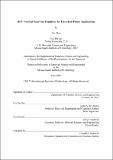| dc.contributor.advisor | Jesús A. del Alamo. | en_US |
| dc.contributor.author | Zhao, Xin, Ph. D. Massachusetts Institute of Technology | en_US |
| dc.contributor.other | Massachusetts Institute of Technology. Department of Materials Science and Engineering. | en_US |
| dc.date.accessioned | 2017-09-15T14:21:33Z | |
| dc.date.available | 2017-09-15T14:21:33Z | |
| dc.date.copyright | 2017 | en_US |
| dc.date.issued | 2017 | en_US |
| dc.identifier.uri | http://hdl.handle.net/1721.1/111256 | |
| dc.description | Thesis: Ph. D., Massachusetts Institute of Technology, Department of Materials Science and Engineering, 2017. | en_US |
| dc.description | This electronic version was submitted by the student author. The certified thesis is available in the Institute Archives and Special Collections. | en_US |
| dc.description | Cataloged from student-submitted PDF version of thesis. | en_US |
| dc.description | Includes bibliographical references (pages 156-166). | en_US |
| dc.description.abstract | Combining the superior carrier transport properties and flexible band structure engineering from III-V materials and ultimate scalability of vertical nanowire (VNW) device architecture, III-V VNW transistors are promising to extend Moore's law further than any other device technology. In this thesis, III-V VNW transistor technology has been pioneered via a top down approach for logic applications in future ultra-low power systems. Process flow and critical modules for sub-10 nm VNW transistors are developed from scratch. A novel dry etch technique based on BCl₃/SiCl₄/Ar chemistry for fabricating sub-20 nm III-V nanostructures with smooth, vertical sidewall and high aspect ratio (> 10) is developed. Digital etch (DE) is shown to mitigate the dry etch damage and reduce NW diameter below 10 nm in a controllable fashion while preserving the sidewall roughness and NW shape. Top-down InGaAs VNW MOSFET is demonstrated for the first time. Record Ion of 224 μA/μm is obtained at Ioff = 100 nA/μm with Vdd = 0.5 V in third generation devices. With novel solvent-based, switching characteristics are observed in devices with diameter as small as 14 nm. The impact of the intrinsic source/drain asymmetry on the device electrical characteristics is studied in detail, highlighting the importance of uniform NW diameter. The first experimental demonstration of III-V VNW TFETs with an InGaAs/InAs heterojunction fabricated by a top-down approach is introduced. Second generation TFETs demonstrate sub-thermal subthreshold characteristics over two orders of magnitude of current and a record high I60 in any experimental TFETs for Vds < 1 V at the time of device fabrication. The comparison of two generations of TFETs confirms oxide/semiconductor interface trapassisted tunneling as the source of significant temperature dependence in the first device generation. Detailed analysis on the conductance-voltage characteristics on both generations of devices reveal a 100-120 mV/dec steepness of Urbach tails in the VNW TFETs. | en_US |
| dc.description.statementofresponsibility | by Xin Zhao. | en_US |
| dc.format.extent | 166 pages | en_US |
| dc.language.iso | eng | en_US |
| dc.publisher | Massachusetts Institute of Technology | en_US |
| dc.rights | MIT theses are protected by copyright. They may be viewed, downloaded, or printed from this source but further reproduction or distribution in any format is prohibited without written permission. | en_US |
| dc.rights.uri | http://dspace.mit.edu/handle/1721.1/7582 | en_US |
| dc.subject | Materials Science and Engineering. | en_US |
| dc.title | III-V vertical nanowire transistor for ultra-low power applications | en_US |
| dc.type | Thesis | en_US |
| dc.description.degree | Ph. D. | en_US |
| dc.contributor.department | Massachusetts Institute of Technology. Department of Materials Science and Engineering | |
| dc.identifier.oclc | 1003290886 | en_US |
